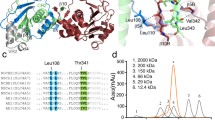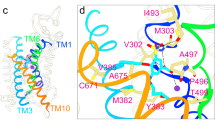Abstract
The members of the neurotransmitter transporter family SLC6A exhibit a high degree of structural homology; however differences arise in many aspects of their transport mechanisms. In this study we report that mouse B0AT1 (mouse Slc6a19) mediates the electrogenic transport of a broad range of neutral amino acids but not of the chemically similar substrates transported by other SLC6A family members. Cotransport of L-Leu and Na+ generates a saturable, reversible, inward current with Michaelis-Menten kinetics (Hill coefficient ~1) yielding a K0.5 for L-Leu of 1.16 mM and for Na+ of 16 mM at a holding potential of −50 mV. Changing the membrane voltage influences both substrate binding and substrate translocation. Li+ can substitute partially for Na+ in the generation of L-Leu-evoked inward currents, whereas both Cl− and H+ concentrations influence its magnitude. The simultaneous measurement of charge translocation and L-Leu uptake in the same cell indicates that B0AT1 transports one Na+ per neutral amino acid. This appears to be accomplished by an ordered, simultaneous mechanism, with the amino acid binding prior to the Na+, followed by the simultaneous translocation of both co-substrates across the plasma membrane. From this kinetic analysis, we conclude that the relatively constant [Na+] along the renal proximal tubule both drives the uptake of neutral amino acids via B0AT1 thermodynamically and ensures that, upon binding, these are translocated efficiently into the cell.





Similar content being viewed by others
References
Adams SV, DeFelice LJ (2002) Flux coupling in the human serotonin transporter. Biophys J 83:3268–3282
Adams SV, DeFelice LJ (2003) Ionic currents in the human serotonin transporter reveal inconsistencies in the alternating access hypothesis. Biophys J 85:1548–1559
Broer A, Klingel K, Kowalczuk S, Rasko JE, Cavanaugh J, Broer S (2004) Molecular cloning of mouse amino acid transport system B0, a neutral amino acid transporter related to Hartnup disorder. J Biol Chem 279:24467–24476
Chen NH, Reith ME, Quick MW (2004) Synaptic uptake and beyond: the sodium- and chloride-dependent neurotransmitter transporter family SLC6. Pflugers Arch 447:519–531
Cleland W (1970) Steady state kinetics, 3rd edn. Academic Press, New York
Doyle FA, McGivan JD (1992) The bovine renal epithelial cell line NBL-1 expresses a broad specificity Na+-dependent neutral amino acid transport system (System Bo) similar to that in bovine renal brush border membrane vesicles. Biochim Biophys Acta 1104:55–62
Evers J, Murer H, Kinne R (1976) Phenylalanine uptake in isolated renal brush border vesicles. Biochim Biophys Acta 426:598–615
Forster IC, Wagner CA, Busch AE, Lang F, Biber J, Hernando N, Murer H, Werner A (1997) Electrophysiological characterization of the flounder type II Na+/Pi cotransporter (NaPi-5) expressed in Xenopus laevis oocytes. J Membr Biol 160:9–25
Frömter E (1979) The Feldberg Lecture 1976. Solute transport across epithelia: what can we learn from micropuncture studies in kidney tubules? J Physiol (Lond) 288:1–31
Grossman TR, Nelson N (2003) Effect of sodium lithium and proton concentrations on the electrophysiological properties of the four mouse GABA transporters expressed in Xenopus oocytes. Neurochem Int 43:431–443
Hidalgo IJ, Borchardt RT (1990) Transport of a large neutral amino acid (phenylalanine) in a human intestinal epithelial cell line: Caco-2. Biochim Biophys Acta 1028:25–30
Kleta R, Romeo E, Ristic Z, Ohura T, Stuart C, Arcos-Burgos M, Dave MH, Wagner CA, Camargo SR, Inoue S, Matsuura N, Helip-Wooley A, Bockenhauer D, Warth R, Bernardini I, Visser G, Eggermann T, Lee P, Chairoungdua A, Jutabha P, Babu E, Nilwarangkoon S, Anzai N, Kanai Y, Verrey F, Gahl WA, Koizumi A (2004) Mutations in SLC6A19, encoding B0AT1, cause Hartnup disorder. Nat Genet 36:999–1002
Lynch AM, McGivan JD (1987) A rapid method for the reconstitution of Na+-dependent neutral amino acid transport from bovine renal brush-border membranes. Biochem J 244:503–508
Mackenzie B, Loo DD, Wright EM (1998) Relationships between Na+/glucose cotransporter (SGLT1) currents and fluxes. J Membr Biol 162:101–106
Meier C, Ristic Z, Klauser S, Verrey F (2002) Activation of system L heterodimeric amino acid exchangers by intracellular substrates. EMBO J 21:580–589
Mircheff AK, Kippen I, Hirayama B, Wright EM (1982) Delineation of sodium-stimulated amino acid transport pathways in rabbit kidney brush border vesicles. J Membr Biol 64:113–122
Munck LK (1997) Comparative aspects of chloride-dependent amino acid transport across the brush-border membrane of mammalian small intestine. Comp Biochem Physiol [A] Physiol 118:229–231
Nozaki J, Dakeishi M, Ohura T, Inoue K, Manabe M, Wada Y, Koizumi A (2001) Homozygosity mapping to chromosome 5p15 of a gene responsible for Hartnup disorder. Biochem Biophys Res Commun 284:255–260
Pan M, Stevens BR (1995) Differentiation- and protein kinase C-dependent regulation of alanine transport via system B. J Biol Chem 270:3582–3587
Quick MW (2003) Regulating the conducting states of a mammalian serotonin transporter. Neuron 40:537–549
Samarzija I, Fromter E (1982) Electrophysiological analysis of rat renal sugar and amino acid transport. III. Neutral amino acids. Pflugers Arch 393:119–209
Schafer JA, Barfuss DW (1980) Mechanisms of transmembrane transport in isolated cells and their experimental study. Pharmacol Ther 10:223–260
Scriver CR (1965) Hartnup disease: a genetic modification of intestinal and renal transport of certain neutral alpha-amino acids. N Engl J Med 273:530–532
Seow HF, Broer S, Broer A, Bailey CG, Potter SJ, Cavanaugh JA, Rasko JE (2004) Hartnup disorder is caused by mutations in the gene encoding the neutral amino acid transporter SLC6A19. Nat Genet 36:1003–1007
Shih VE, Bixby EM, Alpers DH, Bartoscas CS, Thier SO (1971) Studies of intestinal transport defect in Hartnup disease. Gastroenterology 61:445–453
Sigrist-Nelson K, Murer H, Hopfer U (1975) Active alanine transport in isolated brush border membranes. J Biol Chem 250:5674–5680
Silbernagl S (1988) The renal handling of amino acids and oligopeptides. Physiol Rev 68:911–1007
Sonders MS, Zhu SJ, Zahniser NR, Kavanaugh MP, Amara SG (1997) Multiple ionic conductances of the human dopamine transporter: the actions of dopamine and psychostimulants. J Neurosci 17:960–974
Stein WD (1990) Coupling of flows of substrate: antiporters and symporters. Academic Press, San Diego
Stevens BR, Ross HJ, Wright EM (1982) Multiple transport pathways for neutral amino acids in rabbit jejunal brush border vesicles. J Membr Biol 66:213–225
Stevens BR, Kaunitz JD, Wright EM (1984) Intestinal transport of amino acids and sugars: advances using membrane vesicles. Annu Rev Physiol 46:417–433
Takanaga H, Mackenzie B, Suzuki Y, Hediger MA (2005) Identification of mammalian proline transporter SIT1 (SLC6A20) with characteristics of classical system imino. J Biol Chem 280:8974–8984
Weiss JN (1997) The Hill equation revisited: uses and misuses. FASEB J 11:835–841
Wilson JJ, Randles J, Kimmich GA (1996) A model for the kinetic mechanism of sodium-coupled L-alanine transport in LLC-PK1 cells. Am J Physiol 270:C49–56
Acknowledgments
This project was supported by grants to FV from the Swiss National Science Foundation 31-59141.99/02 and the European FP6 project EUGINDAT.
Author information
Authors and Affiliations
Corresponding author
Additional information
S.M.R. Camargo and V. Makrides contributed equally to this work.
Rights and permissions
About this article
Cite this article
Camargo, S.R., Makrides, V., Virkki, L.V. et al. Steady-state kinetic characterization of the mouse B0AT1 sodium-dependent neutral amino acid transporter. Pflugers Arch - Eur J Physiol 451, 338–348 (2005). https://doi.org/10.1007/s00424-005-1455-x
Received:
Accepted:
Published:
Issue Date:
DOI: https://doi.org/10.1007/s00424-005-1455-x




